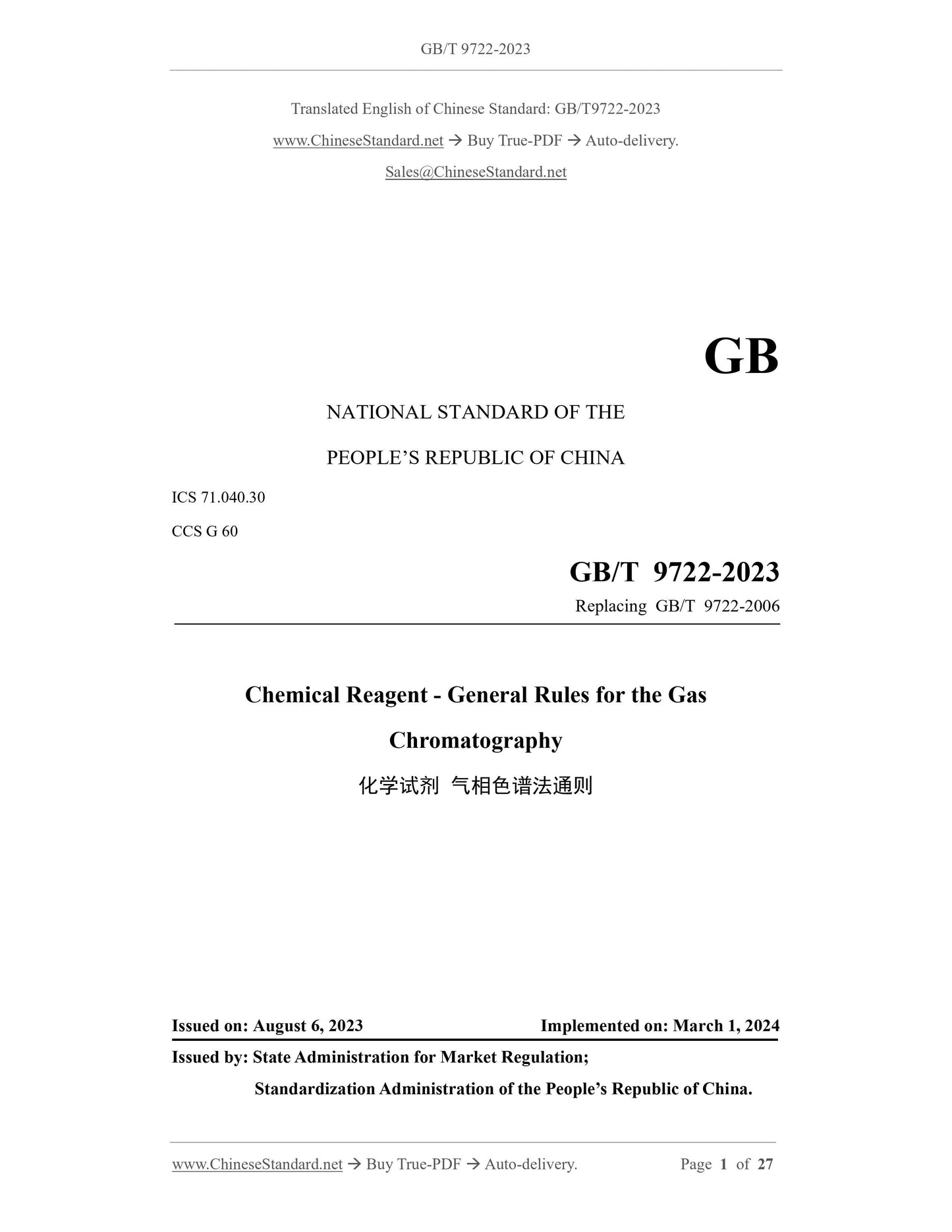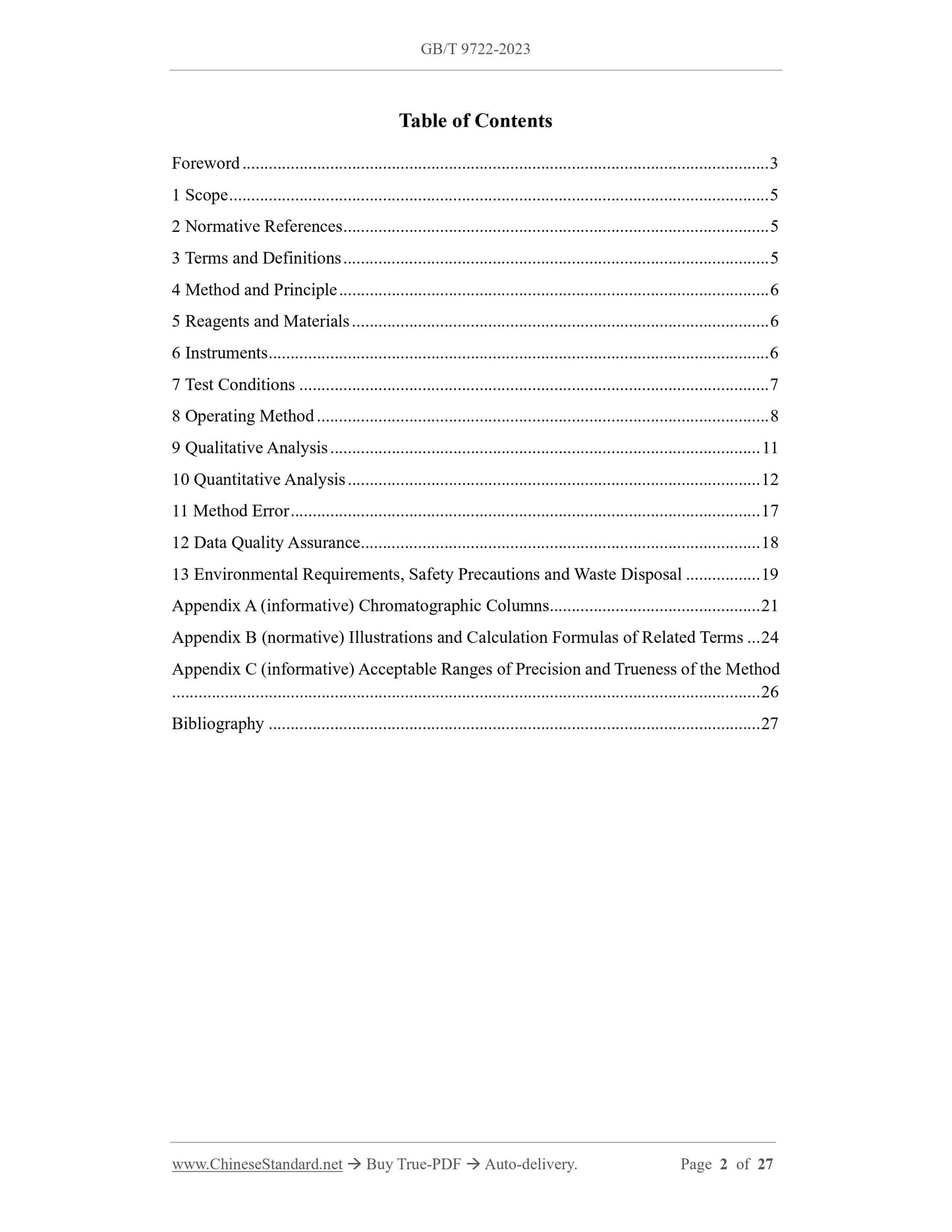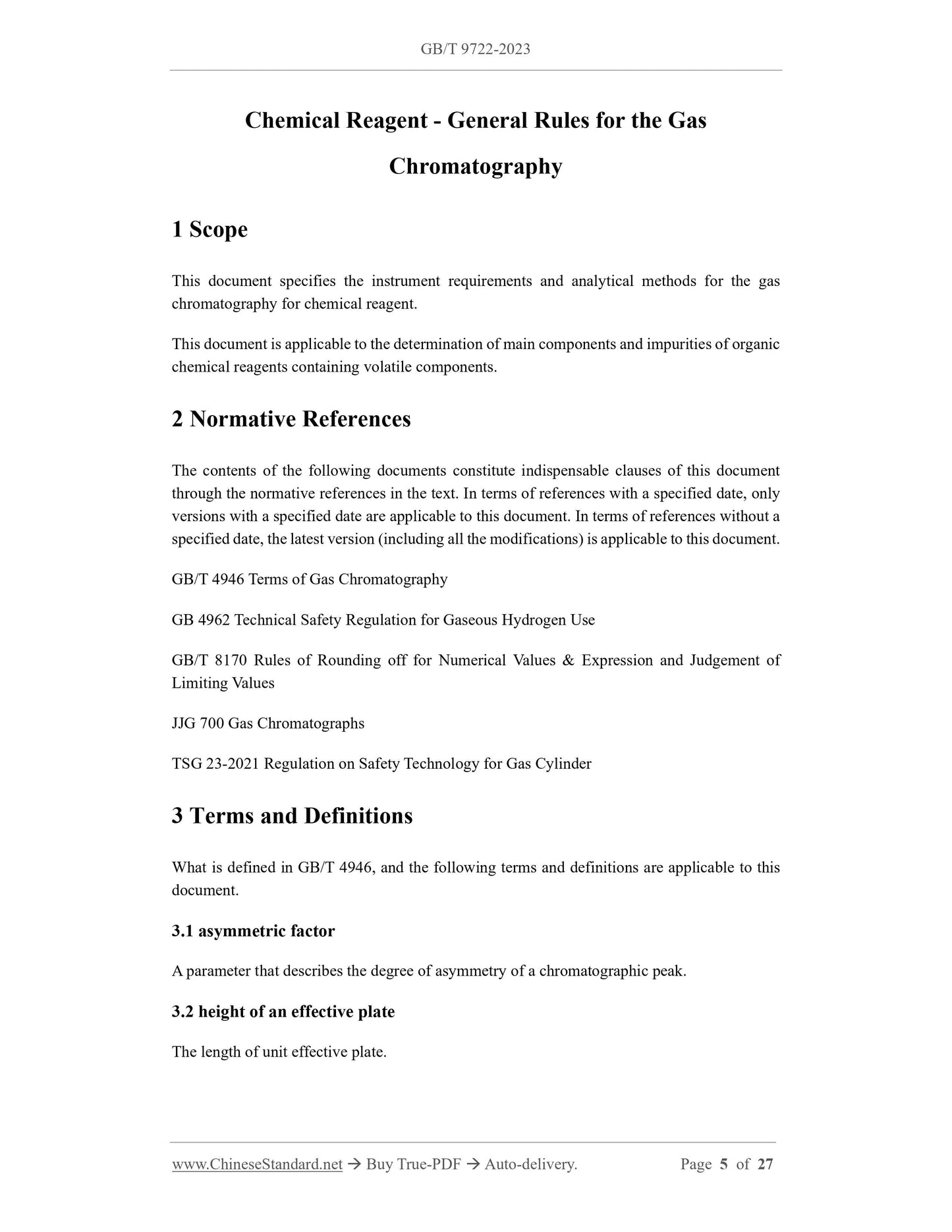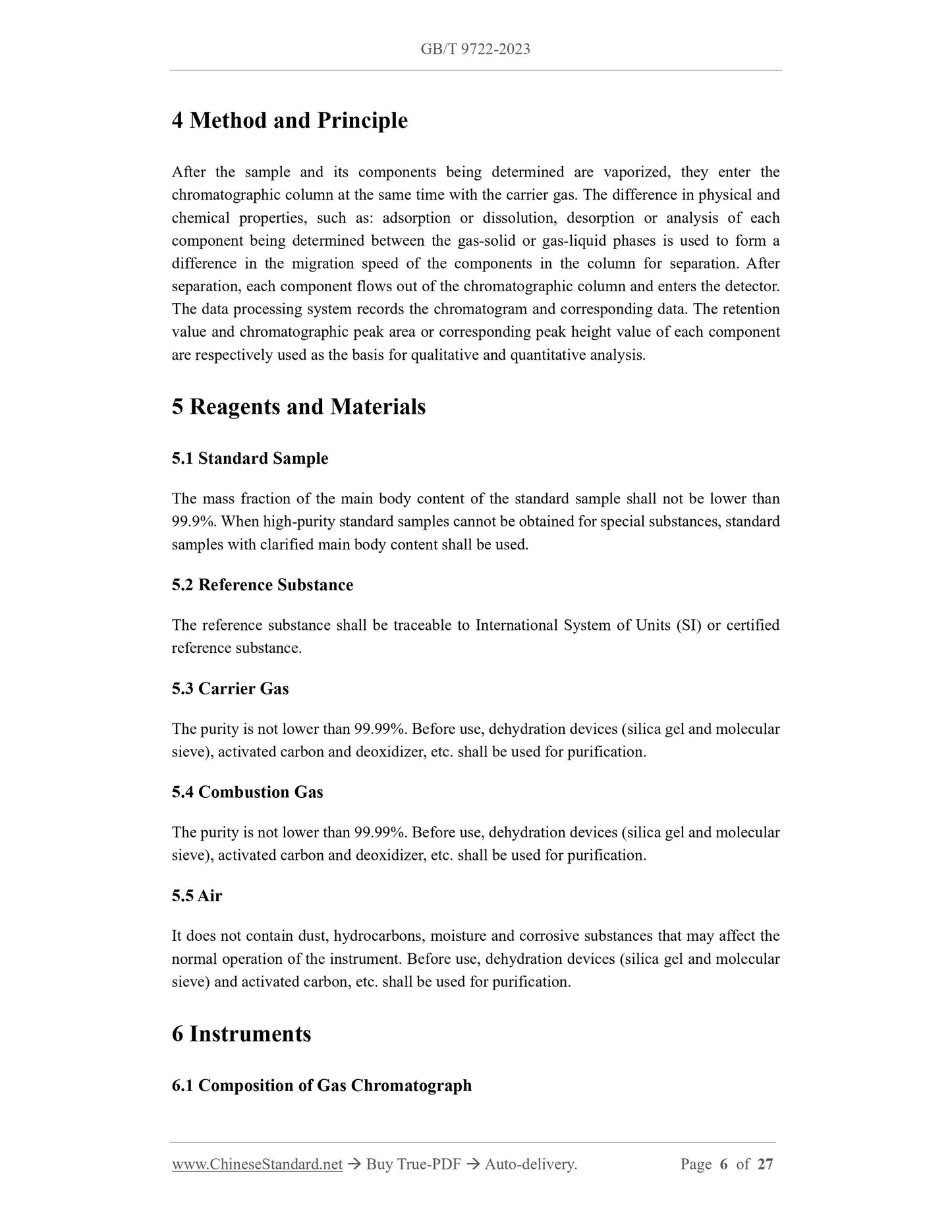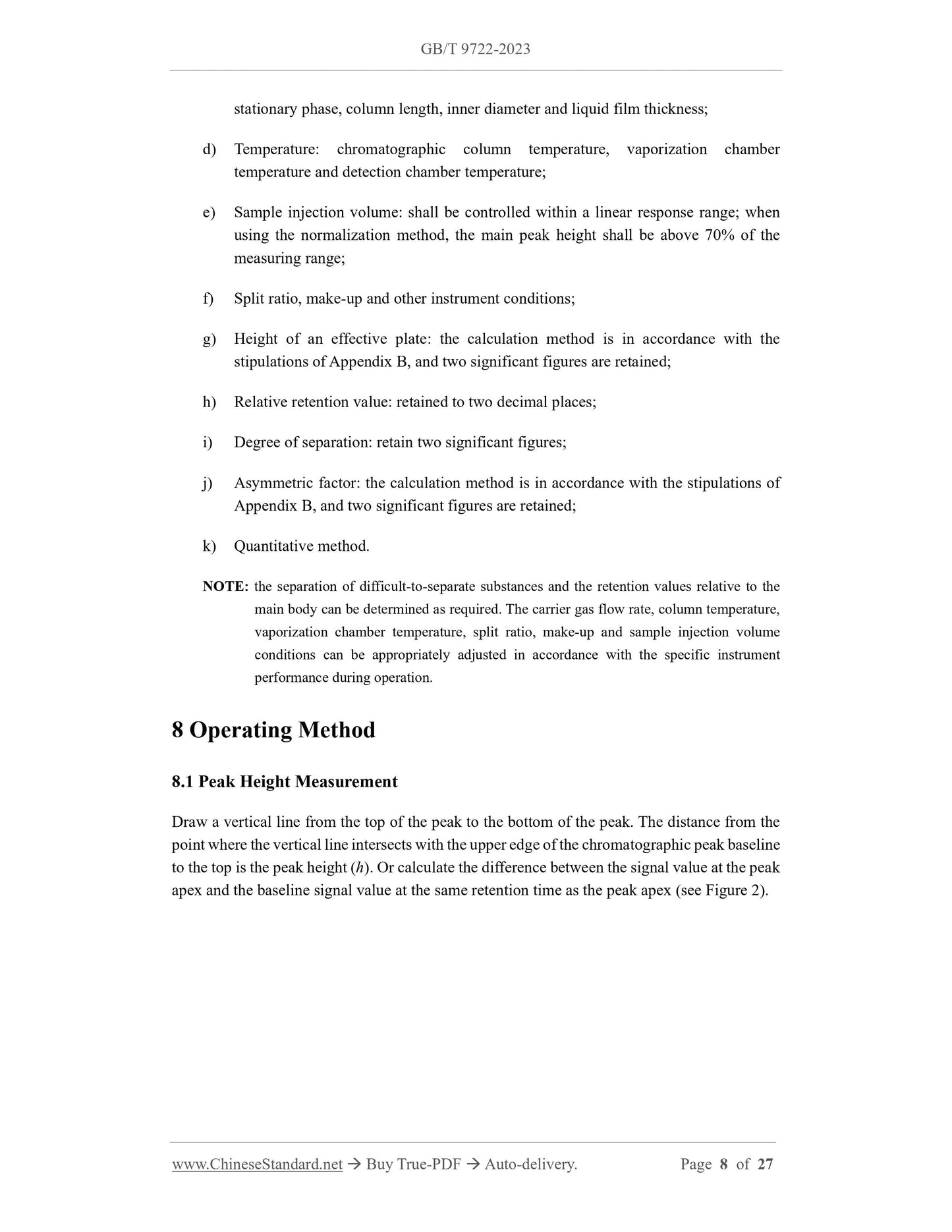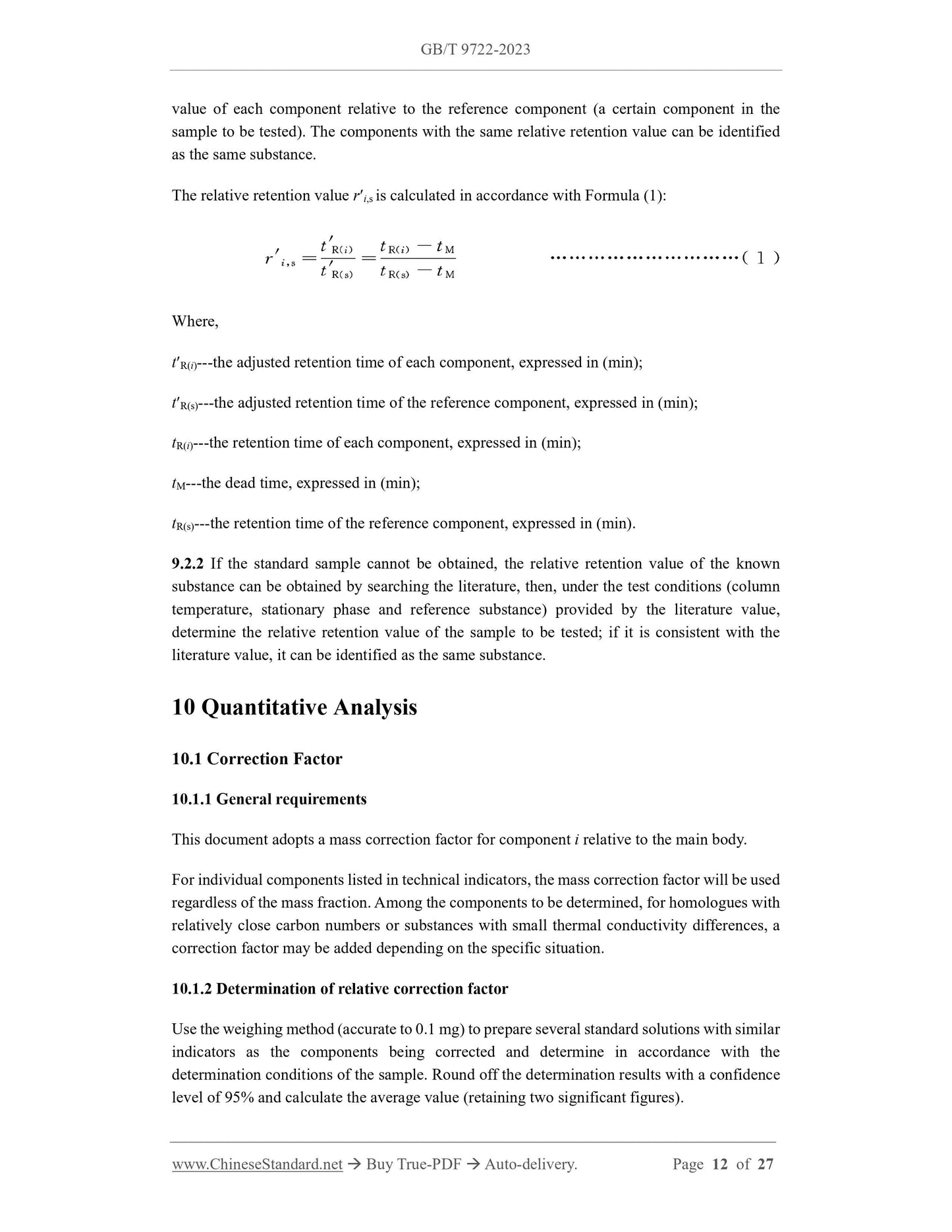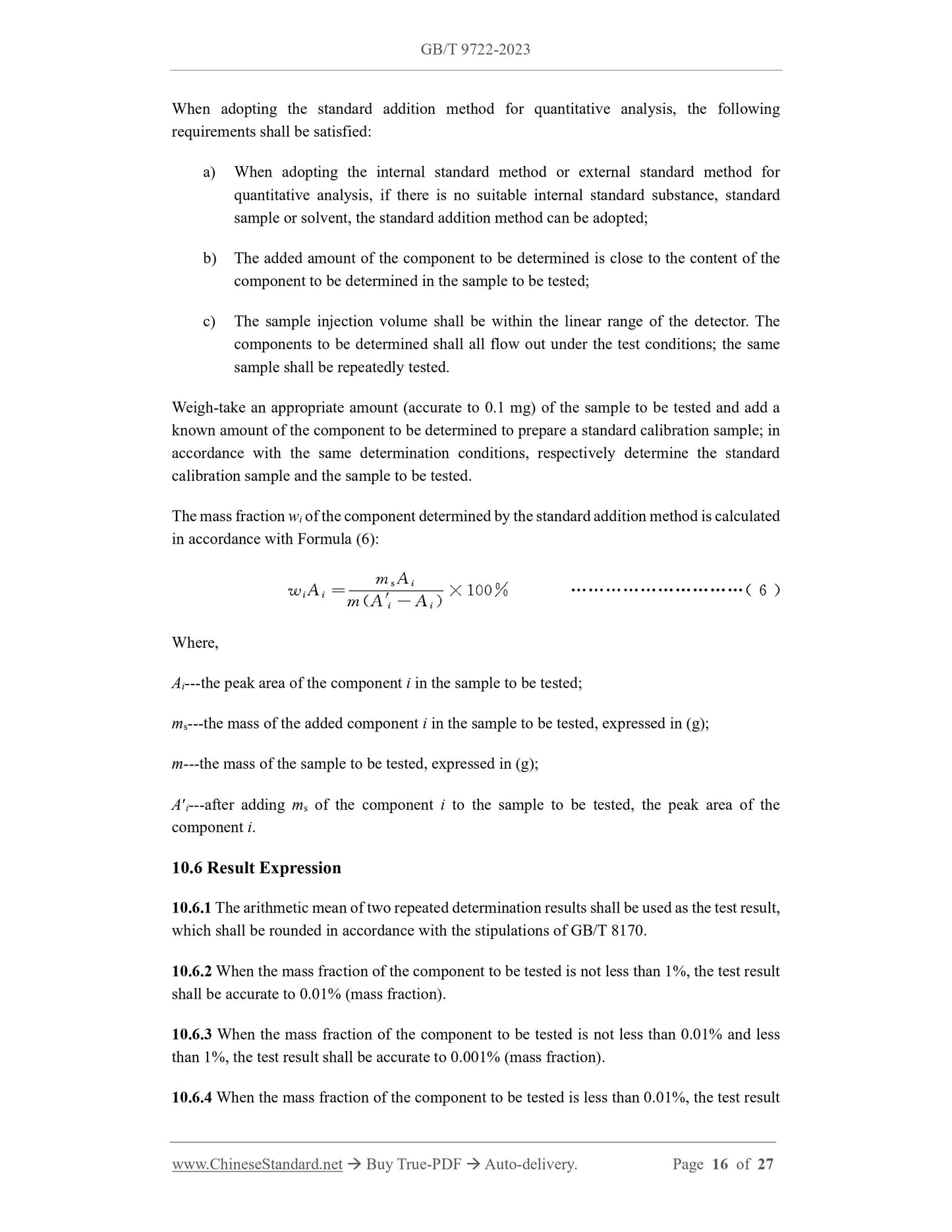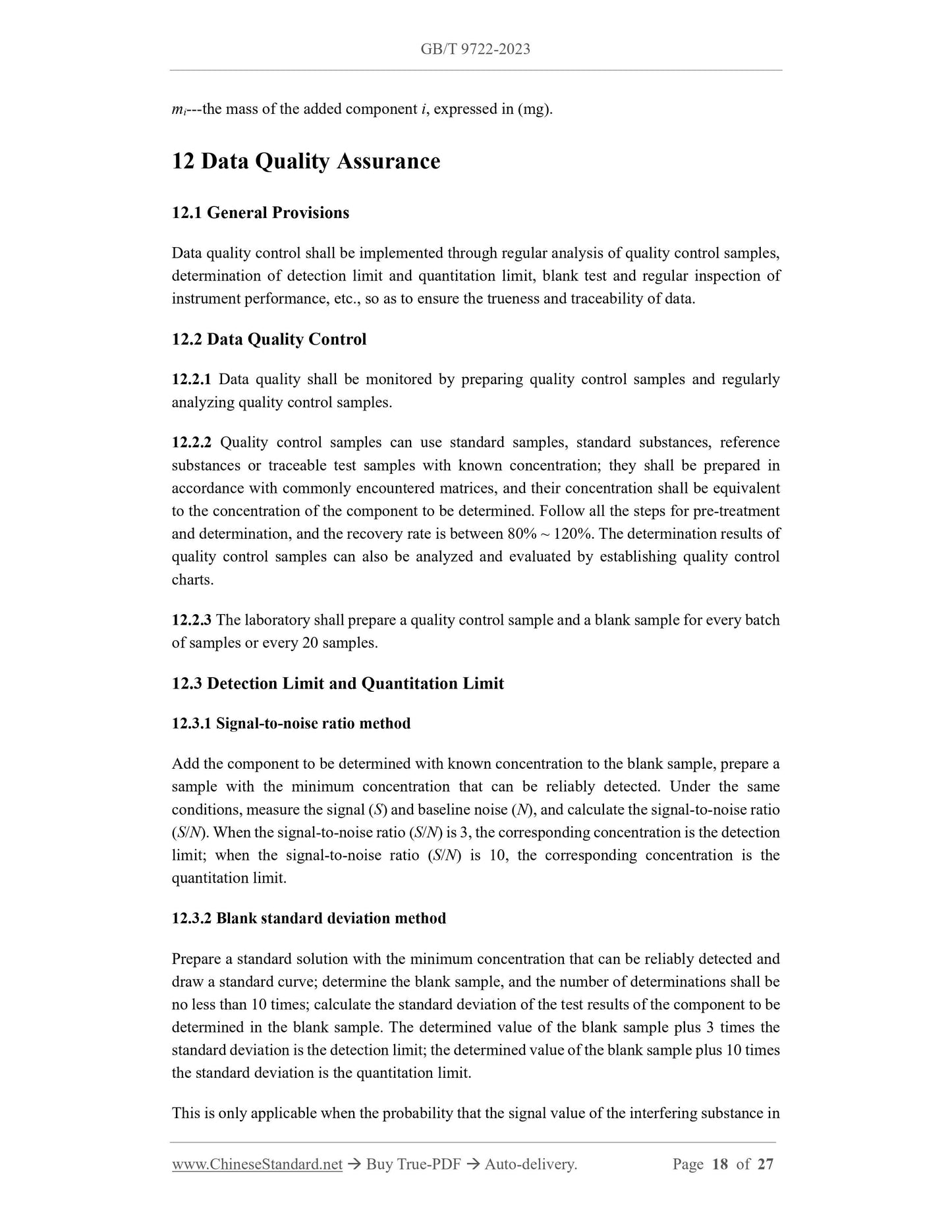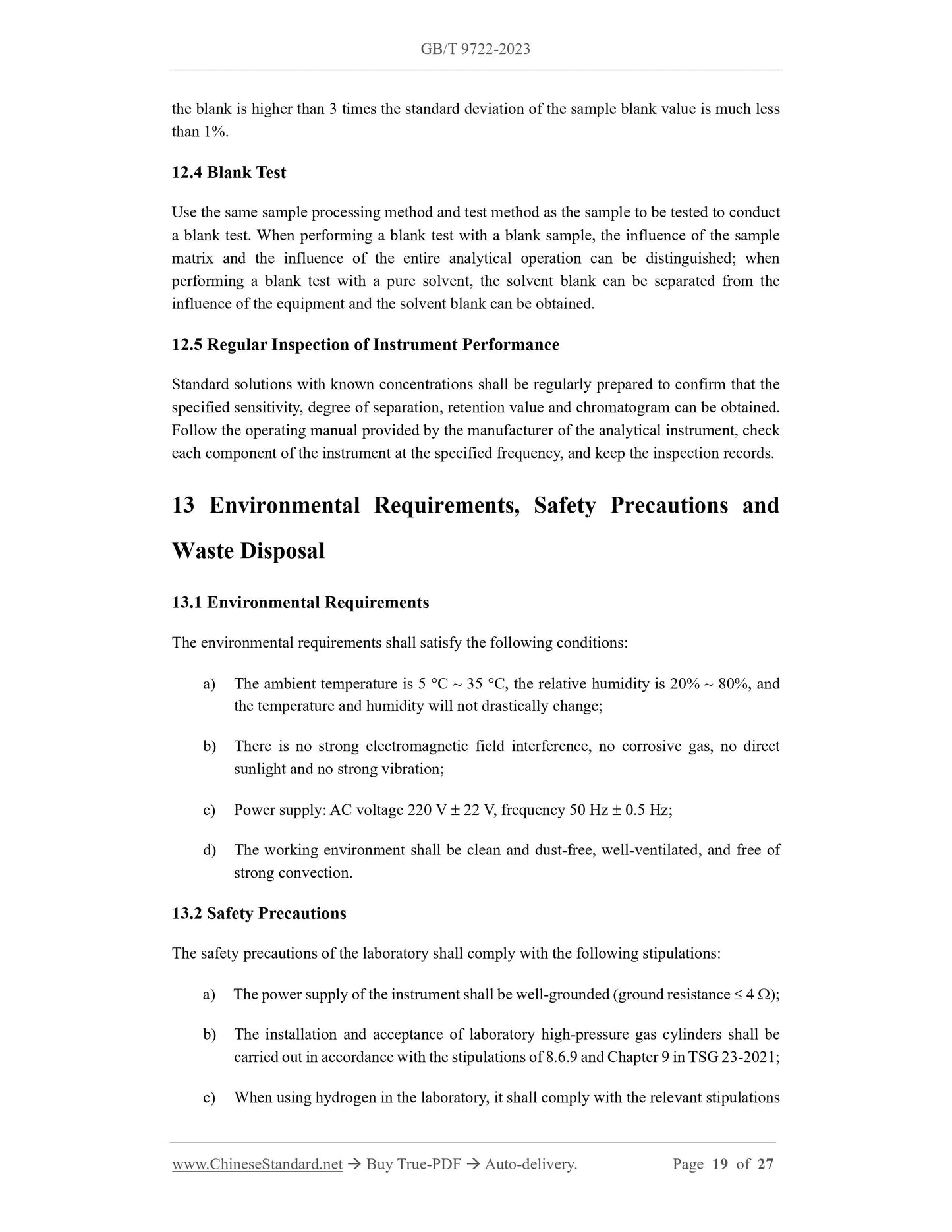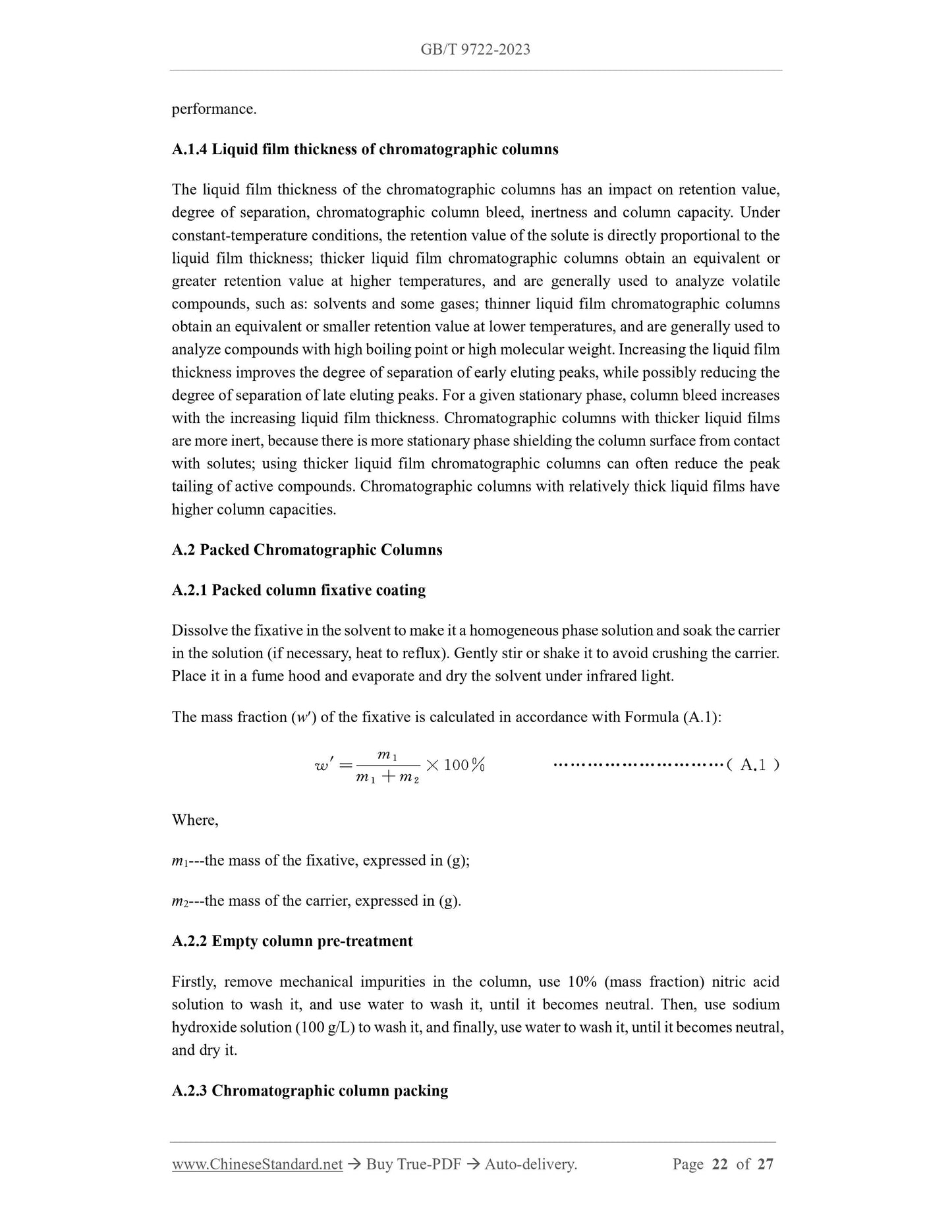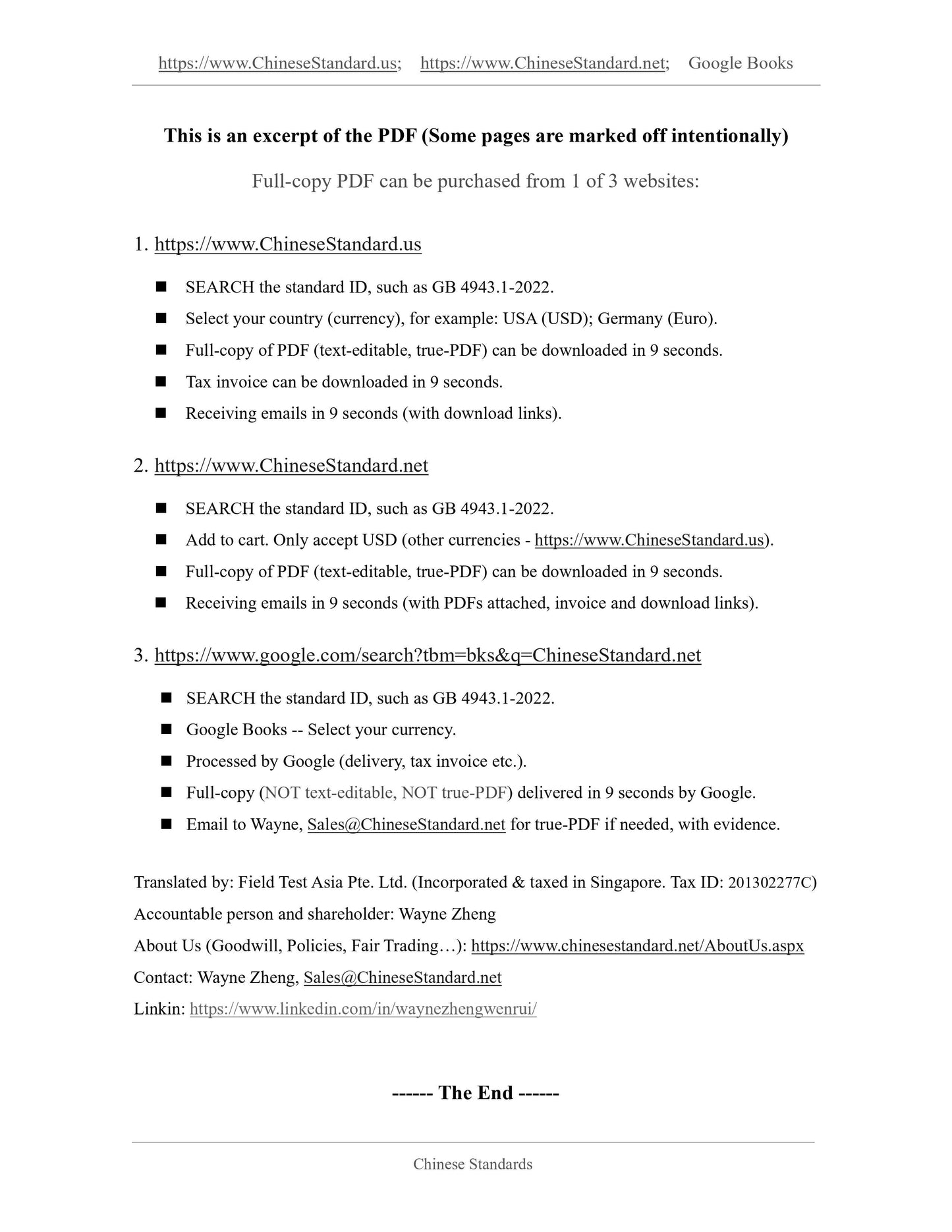1
/
of
11
www.ChineseStandard.us -- Field Test Asia Pte. Ltd.
GB/T 9722-2023 English PDF (GB/T9722-2023)
GB/T 9722-2023 English PDF (GB/T9722-2023)
Regular price
$320.00
Regular price
Sale price
$320.00
Unit price
/
per
Shipping calculated at checkout.
Couldn't load pickup availability
GB/T 9722-2023: Chemical reagent - General rules for the gas chromatography
Delivery: 9 seconds. Download (& Email) true-PDF + Invoice.
Get Quotation: Click GB/T 9722-2023 (Self-service in 1-minute)
Historical versions (Master-website): GB/T 9722-2023
Preview True-PDF (Reload/Scroll-down if blank)
GB/T 9722-2023
GB
NATIONAL STANDARD OF THE
PEOPLE’S REPUBLIC OF CHINA
ICS 71.040.30
CCS G 60
Replacing GB/T 9722-2006
Chemical Reagent - General Rules for the Gas
Chromatography
ISSUED ON: AUGUST 6, 2023
IMPLEMENTED ON: MARCH 1, 2024
Issued by: State Administration for Market Regulation;
Standardization Administration of the People’s Republic of China.
Table of Contents
Foreword ... 3
1 Scope ... 5
2 Normative References ... 5
3 Terms and Definitions ... 5
4 Method and Principle ... 6
5 Reagents and Materials ... 6
6 Instruments ... 6
7 Test Conditions ... 7
8 Operating Method ... 8
9 Qualitative Analysis ... 11
10 Quantitative Analysis ... 12
11 Method Error ... 17
12 Data Quality Assurance ... 18
13 Environmental Requirements, Safety Precautions and Waste Disposal ... 19
Appendix A (informative) Chromatographic Columns ... 21
Appendix B (normative) Illustrations and Calculation Formulas of Related Terms ... 24
Appendix C (informative) Acceptable Ranges of Precision and Trueness of the Method
... 26
Bibliography ... 27
Chemical Reagent - General Rules for the Gas
Chromatography
1 Scope
This document specifies the instrument requirements and analytical methods for the gas
chromatography for chemical reagent.
This document is applicable to the determination of main components and impurities of organic
chemical reagents containing volatile components.
2 Normative References
The contents of the following documents constitute indispensable clauses of this document
through the normative references in the text. In terms of references with a specified date, only
versions with a specified date are applicable to this document. In terms of references without a
specified date, the latest version (including all the modifications) is applicable to this document.
GB/T 4946 Terms of Gas Chromatography
GB 4962 Technical Safety Regulation for Gaseous Hydrogen Use
GB/T 8170 Rules of Rounding off for Numerical Values and Expression and Judgement of
Limiting Values
JJG 700 Gas Chromatographs
TSG 23-2021 Regulation on Safety Technology for Gas Cylinder
3 Terms and Definitions
What is defined in GB/T 4946, and the following terms and definitions are applicable to this
document.
3.1 asymmetric factor
A parameter that describes the degree of asymmetry of a chromatographic peak.
3.2 height of an effective plate
The length of unit effective plate.
4 Method and Principle
After the sample and its components being determined are vaporized, they enter the
chromatographic column at the same time with the carrier gas. The difference in physical and
chemical properties, such as: adsorption or dissolution, desorption or analysis of each
component being determined between the gas-solid or gas-liquid phases is used to form a
difference in the migration speed of the components in the column for separation. After
separation, each component flows out of the chromatographic column and enters the detector.
The data processing system records the chromatogram and corresponding data. The retention
value and chromatographic peak area or corresponding peak height value of each component
are respectively used as the basis for qualitative and quantitative analysis.
5 Reagents and Materials
5.1 Standard Sample
The mass fraction of the main body content of the standard sample shall not be lower than
99.9%. When high-purity standard samples cannot be obtained for special substances, standard
samples with clarified main body content shall be used.
5.2 Reference Substance
The reference substance shall be traceable to International System of Units (SI) or certified
reference substance.
5.3 Carrier Gas
The purity is not lower than 99.99%. Before use, dehydration devices (silica gel and molecular
sieve), activated carbon and deoxidizer, etc. shall be used for purification.
5.4 Combustion Gas
The purity is not lower than 99.99%. Before use, dehydration devices (silica gel and molecular
sieve), activated carbon and deoxidizer, etc. shall be used for purification.
5.5 Air
It does not contain dust, hydrocarbons, moisture and corrosive substances that may affect the
normal operation of the instrument. Before use, dehydration devices (silica gel and molecular
sieve) and activated carbon, etc. shall be used for purification.
6 Instruments
6.1 Composition of Gas Chromatograph
stationary phase, column length, inner diameter and liquid film thickness;
d) Temperature: chromatographic column temperature, vaporization chamber
temperature and detection chamber temperature;
e) Sample injection volume: shall be controlled within a linear response range; when
using the normalization method, the main peak height shall be above 70% of the
measuring range;
f) Split ratio, make-up and other instrument conditions;
g) Height of an effective plate: the calculation method is in accordance with the
stipulations of Appendix B, and two significant figures are retained;
h) Relative retention value: retained to two decimal places;
i) Degree of separation: retain two significant figures;
j) Asymmetric factor: the calculation method is in accordance with the stipulations of
Appendix B, and two significant figures are retained;
k) Quantitative method.
NOTE: the separation of difficult-to-separate substances and the retention values relative to the
main body can be determined as required. The carrier gas flow rate, column temperature,
vaporization chamber temperature, split ratio, make-up and sample injection volume
conditions can be appropriately adjusted in accordance with the specific instrument
performance during operation.
8 Operating Method
8.1 Peak Height Measurement
Draw a vertical line from the top of the peak to the bottom of the peak. The distance from the
point where the vertical line intersects with the upper edge of the chromatographic peak baseline
to the top is the peak height (h). Or calculate the difference between the signal value at the peak
apex and the baseline signal value at the same retention time as the peak apex (see Figure 2).
value of each component relative to the reference component (a certain component in the
sample to be tested). The components with the same relative retention value can be identified
as the same substance.
The relative retention value ri,s is calculated in accordance with Formula (1):
Where,
tR(i)---the adjusted retention time of each component, expressed in (min);
tR(s)---the adjusted retention time of the reference component, expressed in (min);
tR(i)---the retention time of each component, expressed in (min);
tM---the dead time, expressed in (min);
tR(s)---the retention time of the reference component, expressed in (min).
9.2.2 If the standard sample cannot be obtained, the relative retention value of the known
substance can be obtained by searching the literature, then, under the test conditions (column
temperature, stationary phase and reference substance) provided by the literature value,
determine the relative retention value of the sample to be tested; if it is consistent with the
literature value, it can be identified as the same substance.
10 Quantitative Analysis
10.1 Correction Factor
10.1.1 General requirements
This document adopts a mass correction factor for component i relative to the main body.
For individual components listed in technical indicators, the mass correction factor will be used
regardless of the mass fraction. Among the components to be determined, for homologues with
relatively close carbon numbers or substances with small thermal conductivity differences, a
correction factor may be added depending on the specific situation.
10.1.2 Determination of relative correction factor
Use the weighing method (accurate to 0.1 mg) to prepare several standard solutions with similar
indicators as the components being corrected and determine in accordance with the
determination conditions of the sample. Round off the determination results with a confidence
level of 95% and calculate the average value (retaining two significant figures).
When adopting the standard addition method for quantitative analysis, the following
requirements shall be satisfied:
a) When adopting the internal standard method or external standard method for
quantitative analysis, if there is no suitable internal standard substance, standard
sample or solvent, the standard addition method can be adopted;
b) The added amount of the component to be determined is close to the content of the
component to be determined in the sample to be tested;
c) The sample injection volume shall be within the linear range of the detector. The
components to be determined shall all flow out under the test conditions; the same
sample shall be repeatedly tested.
Weigh-take an appropriate amount (accurate to 0.1 mg) of the sample to be tested and add a
known amount of the component to be determined to prepare a standard calibration sample; in
accordance with the same determination conditions, respectively determine the standard
calibration sample and the sample to be tested.
The mass fraction wi of the component determined by the standard addition method is calculated
in accordance with Formula (6):
Where,
Ai---the peak area of the component i in the sample to be tested;
ms---the mass of the added component i in the sample to be tested, expressed in (g);
m---the mass of the sample to be tested, expressed in (g);
Ai---after adding ms of the component i to the sample to be tested, the peak area of the
component i.
10.6 Result Expression
10.6.1 The arithmetic mean of two repeated determination results shall be used as the test result,
which shall be rounded in accordance with the stipulations of GB/T 8170.
10.6.2 When the mass fraction of the component to be tested is not less than 1%, the test result
shall be accurate to 0.01% (mass fraction).
10.6.3 When the mass fraction of the component to be tested is not less than 0.01% and less
than 1%, the test result shall be accurate to 0.001% (mass fraction).
10.6.4 When the mass fraction of the component to be tested is less than 0.01%, the test result
mi---the mass of the added component i, expressed in (mg).
12 Data Quality Assurance
12.1 General Provisions
Data quality control shall be implemented through regular analysis of quality control samples,
determination of detection limit and quantitation limit, blank test and regular inspection of
instrument performance, etc., so as to ensure the trueness and traceability of data.
12.2 Data Quality Control
12.2.1 Data quality shall be monitored by preparing quality control samples and regularly
analyzing quality control samples.
12.2.2 Quality control samples can use standard samples, standard substances, reference
substances or traceable test samples with known concentration; they shall be prepared in
accordance with commonly encountered matrices, and their concentration shall be equivalent
to the concentration of the component to be determined. Follow all the steps for pre-treatment
and determination, and the recovery rate is between 80% ~ 120%. The determination results of
quality control samples can also be analyzed and evaluated by establishing quality control
charts.
12.2.3 The laboratory shall prepare a quality control sample and a blank sample for every batch
of samples or every 20 samples.
12.3 Detection Limit and Quantitation Limit
12.3.1 Signal-to-noise ratio method
Add the component to be determined with known concentration to the blank sample, prepare a
sample with the minimum concentration that can be reliably detected. Under the same
conditions, measure the signal (S) and baseline noise (N), and calculate the signal-to-noise ratio
(S/N). When the signal-to-noise ratio (S/N) is 3, the corresponding concentration is the detection
limit; when the signal-to-noise ratio (S/N) is 10, the corresponding concentration is the
quantitation limit.
12.3.2 Blank standard deviation method
Prepare a standard solution with the minimum concentration that can be reliably detected and
draw a standard curve; determine the blank sample, and the number of determinations shall be
no less than 10 times; calculate the standard deviation of the test results of the component to be
determined in the blank sample. The determined value of the blank sample plus 3 times the
standard deviation is the detection limit; the determined value of the blank sample plus 10 times
the standard deviation is the quantitation limit.
This is only applicable when the probability that the signal value of the interfering substance in
the blank is higher than 3 times the standard deviation of the sample blank value is much less
than 1%.
12.4 Blank Test
Use the same sample processing method and test method as the sample to be tested to conduct
a blank test. When performing a blank test with a blank sample, the influence of the sample
matrix and the influence of the entire analytical operation can be distinguished; when
performing a blank test with a pure solvent, the solvent blank can be separated from the
influence of the equipment and the solvent blank can be obtained.
12.5 Regular Inspection of Instrument Performance
Standard solutions with known concentrations shall be regularly prepared to confirm that the
specified sensitivity, degree of separation, retention value and chromatogram can be obtained.
Follow the operating manual provided by the manufacturer of the analytical instrument, check
each component of the instrument at the specified frequency, and keep the inspection records.
13 Environmental Requirements, Safety Precautions and
Waste Disposal
13.1 Environmental Requirements
The environmental requirements shall satisfy the following conditions:
a) The ambient temperature is 5 C ~ 35 C, the relative humidity is 20% ~ 80%, and
the temperature and humidity will not drastically change;
b) There is no strong electromagnetic field interference, no corrosive gas, no direct
sunlight and no strong vibration;
c) Power sup...
Delivery: 9 seconds. Download (& Email) true-PDF + Invoice.
Get Quotation: Click GB/T 9722-2023 (Self-service in 1-minute)
Historical versions (Master-website): GB/T 9722-2023
Preview True-PDF (Reload/Scroll-down if blank)
GB/T 9722-2023
GB
NATIONAL STANDARD OF THE
PEOPLE’S REPUBLIC OF CHINA
ICS 71.040.30
CCS G 60
Replacing GB/T 9722-2006
Chemical Reagent - General Rules for the Gas
Chromatography
ISSUED ON: AUGUST 6, 2023
IMPLEMENTED ON: MARCH 1, 2024
Issued by: State Administration for Market Regulation;
Standardization Administration of the People’s Republic of China.
Table of Contents
Foreword ... 3
1 Scope ... 5
2 Normative References ... 5
3 Terms and Definitions ... 5
4 Method and Principle ... 6
5 Reagents and Materials ... 6
6 Instruments ... 6
7 Test Conditions ... 7
8 Operating Method ... 8
9 Qualitative Analysis ... 11
10 Quantitative Analysis ... 12
11 Method Error ... 17
12 Data Quality Assurance ... 18
13 Environmental Requirements, Safety Precautions and Waste Disposal ... 19
Appendix A (informative) Chromatographic Columns ... 21
Appendix B (normative) Illustrations and Calculation Formulas of Related Terms ... 24
Appendix C (informative) Acceptable Ranges of Precision and Trueness of the Method
... 26
Bibliography ... 27
Chemical Reagent - General Rules for the Gas
Chromatography
1 Scope
This document specifies the instrument requirements and analytical methods for the gas
chromatography for chemical reagent.
This document is applicable to the determination of main components and impurities of organic
chemical reagents containing volatile components.
2 Normative References
The contents of the following documents constitute indispensable clauses of this document
through the normative references in the text. In terms of references with a specified date, only
versions with a specified date are applicable to this document. In terms of references without a
specified date, the latest version (including all the modifications) is applicable to this document.
GB/T 4946 Terms of Gas Chromatography
GB 4962 Technical Safety Regulation for Gaseous Hydrogen Use
GB/T 8170 Rules of Rounding off for Numerical Values and Expression and Judgement of
Limiting Values
JJG 700 Gas Chromatographs
TSG 23-2021 Regulation on Safety Technology for Gas Cylinder
3 Terms and Definitions
What is defined in GB/T 4946, and the following terms and definitions are applicable to this
document.
3.1 asymmetric factor
A parameter that describes the degree of asymmetry of a chromatographic peak.
3.2 height of an effective plate
The length of unit effective plate.
4 Method and Principle
After the sample and its components being determined are vaporized, they enter the
chromatographic column at the same time with the carrier gas. The difference in physical and
chemical properties, such as: adsorption or dissolution, desorption or analysis of each
component being determined between the gas-solid or gas-liquid phases is used to form a
difference in the migration speed of the components in the column for separation. After
separation, each component flows out of the chromatographic column and enters the detector.
The data processing system records the chromatogram and corresponding data. The retention
value and chromatographic peak area or corresponding peak height value of each component
are respectively used as the basis for qualitative and quantitative analysis.
5 Reagents and Materials
5.1 Standard Sample
The mass fraction of the main body content of the standard sample shall not be lower than
99.9%. When high-purity standard samples cannot be obtained for special substances, standard
samples with clarified main body content shall be used.
5.2 Reference Substance
The reference substance shall be traceable to International System of Units (SI) or certified
reference substance.
5.3 Carrier Gas
The purity is not lower than 99.99%. Before use, dehydration devices (silica gel and molecular
sieve), activated carbon and deoxidizer, etc. shall be used for purification.
5.4 Combustion Gas
The purity is not lower than 99.99%. Before use, dehydration devices (silica gel and molecular
sieve), activated carbon and deoxidizer, etc. shall be used for purification.
5.5 Air
It does not contain dust, hydrocarbons, moisture and corrosive substances that may affect the
normal operation of the instrument. Before use, dehydration devices (silica gel and molecular
sieve) and activated carbon, etc. shall be used for purification.
6 Instruments
6.1 Composition of Gas Chromatograph
stationary phase, column length, inner diameter and liquid film thickness;
d) Temperature: chromatographic column temperature, vaporization chamber
temperature and detection chamber temperature;
e) Sample injection volume: shall be controlled within a linear response range; when
using the normalization method, the main peak height shall be above 70% of the
measuring range;
f) Split ratio, make-up and other instrument conditions;
g) Height of an effective plate: the calculation method is in accordance with the
stipulations of Appendix B, and two significant figures are retained;
h) Relative retention value: retained to two decimal places;
i) Degree of separation: retain two significant figures;
j) Asymmetric factor: the calculation method is in accordance with the stipulations of
Appendix B, and two significant figures are retained;
k) Quantitative method.
NOTE: the separation of difficult-to-separate substances and the retention values relative to the
main body can be determined as required. The carrier gas flow rate, column temperature,
vaporization chamber temperature, split ratio, make-up and sample injection volume
conditions can be appropriately adjusted in accordance with the specific instrument
performance during operation.
8 Operating Method
8.1 Peak Height Measurement
Draw a vertical line from the top of the peak to the bottom of the peak. The distance from the
point where the vertical line intersects with the upper edge of the chromatographic peak baseline
to the top is the peak height (h). Or calculate the difference between the signal value at the peak
apex and the baseline signal value at the same retention time as the peak apex (see Figure 2).
value of each component relative to the reference component (a certain component in the
sample to be tested). The components with the same relative retention value can be identified
as the same substance.
The relative retention value ri,s is calculated in accordance with Formula (1):
Where,
tR(i)---the adjusted retention time of each component, expressed in (min);
tR(s)---the adjusted retention time of the reference component, expressed in (min);
tR(i)---the retention time of each component, expressed in (min);
tM---the dead time, expressed in (min);
tR(s)---the retention time of the reference component, expressed in (min).
9.2.2 If the standard sample cannot be obtained, the relative retention value of the known
substance can be obtained by searching the literature, then, under the test conditions (column
temperature, stationary phase and reference substance) provided by the literature value,
determine the relative retention value of the sample to be tested; if it is consistent with the
literature value, it can be identified as the same substance.
10 Quantitative Analysis
10.1 Correction Factor
10.1.1 General requirements
This document adopts a mass correction factor for component i relative to the main body.
For individual components listed in technical indicators, the mass correction factor will be used
regardless of the mass fraction. Among the components to be determined, for homologues with
relatively close carbon numbers or substances with small thermal conductivity differences, a
correction factor may be added depending on the specific situation.
10.1.2 Determination of relative correction factor
Use the weighing method (accurate to 0.1 mg) to prepare several standard solutions with similar
indicators as the components being corrected and determine in accordance with the
determination conditions of the sample. Round off the determination results with a confidence
level of 95% and calculate the average value (retaining two significant figures).
When adopting the standard addition method for quantitative analysis, the following
requirements shall be satisfied:
a) When adopting the internal standard method or external standard method for
quantitative analysis, if there is no suitable internal standard substance, standard
sample or solvent, the standard addition method can be adopted;
b) The added amount of the component to be determined is close to the content of the
component to be determined in the sample to be tested;
c) The sample injection volume shall be within the linear range of the detector. The
components to be determined shall all flow out under the test conditions; the same
sample shall be repeatedly tested.
Weigh-take an appropriate amount (accurate to 0.1 mg) of the sample to be tested and add a
known amount of the component to be determined to prepare a standard calibration sample; in
accordance with the same determination conditions, respectively determine the standard
calibration sample and the sample to be tested.
The mass fraction wi of the component determined by the standard addition method is calculated
in accordance with Formula (6):
Where,
Ai---the peak area of the component i in the sample to be tested;
ms---the mass of the added component i in the sample to be tested, expressed in (g);
m---the mass of the sample to be tested, expressed in (g);
Ai---after adding ms of the component i to the sample to be tested, the peak area of the
component i.
10.6 Result Expression
10.6.1 The arithmetic mean of two repeated determination results shall be used as the test result,
which shall be rounded in accordance with the stipulations of GB/T 8170.
10.6.2 When the mass fraction of the component to be tested is not less than 1%, the test result
shall be accurate to 0.01% (mass fraction).
10.6.3 When the mass fraction of the component to be tested is not less than 0.01% and less
than 1%, the test result shall be accurate to 0.001% (mass fraction).
10.6.4 When the mass fraction of the component to be tested is less than 0.01%, the test result
mi---the mass of the added component i, expressed in (mg).
12 Data Quality Assurance
12.1 General Provisions
Data quality control shall be implemented through regular analysis of quality control samples,
determination of detection limit and quantitation limit, blank test and regular inspection of
instrument performance, etc., so as to ensure the trueness and traceability of data.
12.2 Data Quality Control
12.2.1 Data quality shall be monitored by preparing quality control samples and regularly
analyzing quality control samples.
12.2.2 Quality control samples can use standard samples, standard substances, reference
substances or traceable test samples with known concentration; they shall be prepared in
accordance with commonly encountered matrices, and their concentration shall be equivalent
to the concentration of the component to be determined. Follow all the steps for pre-treatment
and determination, and the recovery rate is between 80% ~ 120%. The determination results of
quality control samples can also be analyzed and evaluated by establishing quality control
charts.
12.2.3 The laboratory shall prepare a quality control sample and a blank sample for every batch
of samples or every 20 samples.
12.3 Detection Limit and Quantitation Limit
12.3.1 Signal-to-noise ratio method
Add the component to be determined with known concentration to the blank sample, prepare a
sample with the minimum concentration that can be reliably detected. Under the same
conditions, measure the signal (S) and baseline noise (N), and calculate the signal-to-noise ratio
(S/N). When the signal-to-noise ratio (S/N) is 3, the corresponding concentration is the detection
limit; when the signal-to-noise ratio (S/N) is 10, the corresponding concentration is the
quantitation limit.
12.3.2 Blank standard deviation method
Prepare a standard solution with the minimum concentration that can be reliably detected and
draw a standard curve; determine the blank sample, and the number of determinations shall be
no less than 10 times; calculate the standard deviation of the test results of the component to be
determined in the blank sample. The determined value of the blank sample plus 3 times the
standard deviation is the detection limit; the determined value of the blank sample plus 10 times
the standard deviation is the quantitation limit.
This is only applicable when the probability that the signal value of the interfering substance in
the blank is higher than 3 times the standard deviation of the sample blank value is much less
than 1%.
12.4 Blank Test
Use the same sample processing method and test method as the sample to be tested to conduct
a blank test. When performing a blank test with a blank sample, the influence of the sample
matrix and the influence of the entire analytical operation can be distinguished; when
performing a blank test with a pure solvent, the solvent blank can be separated from the
influence of the equipment and the solvent blank can be obtained.
12.5 Regular Inspection of Instrument Performance
Standard solutions with known concentrations shall be regularly prepared to confirm that the
specified sensitivity, degree of separation, retention value and chromatogram can be obtained.
Follow the operating manual provided by the manufacturer of the analytical instrument, check
each component of the instrument at the specified frequency, and keep the inspection records.
13 Environmental Requirements, Safety Precautions and
Waste Disposal
13.1 Environmental Requirements
The environmental requirements shall satisfy the following conditions:
a) The ambient temperature is 5 C ~ 35 C, the relative humidity is 20% ~ 80%, and
the temperature and humidity will not drastically change;
b) There is no strong electromagnetic field interference, no corrosive gas, no direct
sunlight and no strong vibration;
c) Power sup...
Share
